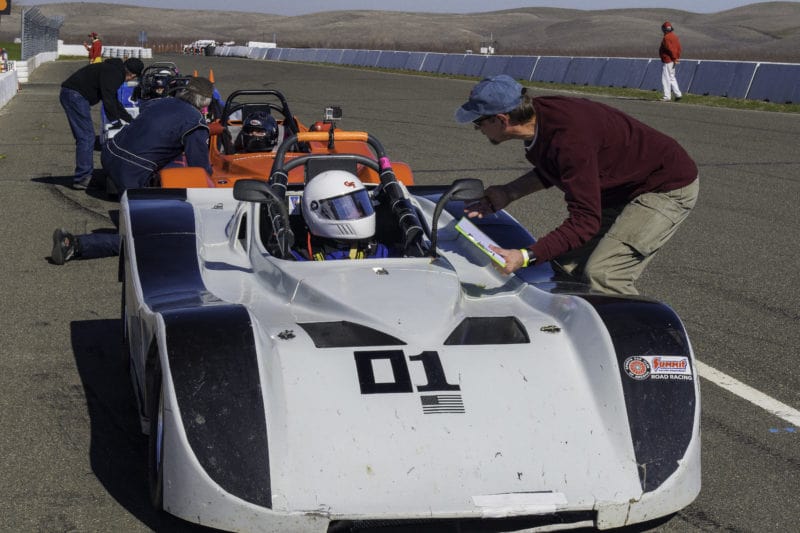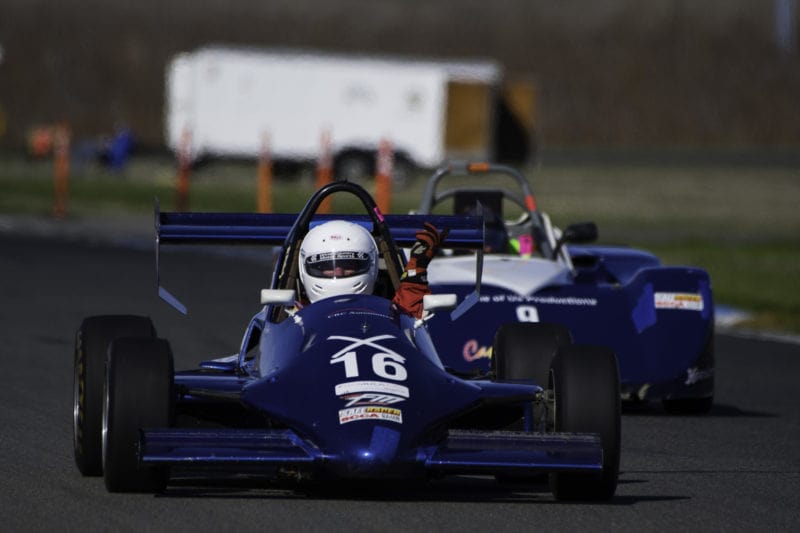SFR’S ONCE-A-YEAR COMPETITION LICENSING SCHOOL

February 28 – March 2, 2025 AT THUNDERHILL RACEWAY PARK.
2025 Entry fees $1195
The three-day school consists of on-track training with instruction by nationally licensed drivers, practice starts and races, and personal download sessions to discuss your driving sessions. Ground school will be covered in an online class to be completed before the school weekend. On completing the school, students receive an SCCA Novice Permit which allows them to enter SCCA Regional Road Racing events anywhere in the US.
If you have previous competitive racing (not track day) experience, you may be able to skip the school: Waiver Process for those with previous racing experience
EVERYDAY DRIVER SCHOOL VIDEO
Paul and Todd from Everyday Driver attended the school and produced a great video. The video can be watched on YouTube or through Amazon Prime. The link to the YouTube video is:
START HERE
-
- Join SCCA if you are not already a member: you can join online at any time on the National SCCA web page
- Schedule your physical and have doctor completely fill out SCCA Physical Form .
- Fill out the Novice Permit Application
- Send to National SCCA Licensing: Physical form, novice application, and copy of current state driver’s license: licensing@scca.com
UPS/FedEx/ address: SCCA, 6700 SW Topeka Blvd., Bldg. 300, Topeka KS 66619
USPS address: SCCA, PO Box 19400, PO Box 299, Topeka KS 666015. - Enter the school at http://sfrscca.motorsportreg.com/
You do not need to have your novice permit before you enter the school (but you should be working on it). Credit cards are not charged until after the school. Entering allows us to send you any updated info and help you make sure you have everything you need before the school starts.
Contact the Region Office if you have any questions: 888-995-7222 / 530-934-4455 or office@sfrscca.live-website.com .
About three weeks after sending in the required paperwork, you will receive your Novice permit and a current copy of the GCR (General Competition Rules) book in the mail from the Topeka office of SCCA. The GCR provides information on specific vehicles, car classification, and equipment and safety requirements. Students should pay special attention to the section on flags.
SAFETY GEAR REQUIRED
While waiting for school day, you can gather all the required driver’s gear:
- Helmet with a Snell sticker of 2015 or later,
- Head and Neck Restraints meeting SFI 38.1 or FIA 8858
- One-piece driver’s suit that covers the entire body from the neck to the ankles and wrists. All suits shall bear an SFI 3.2A/1 (or FIA 1986 Standard) or higher, underwear of fire-resistant material unless you have a drivers suit SFI 3.2A/5 or higher.
- Gloves, driving shoes and socks made of fire-resistant material
- Arm Restraints are required for open cockpit cars (formula cars, sports racers, & SpecRacer Fords)
All this is described in detail in the General Competition Regulations (GCR) which is also available online at www.scca.com on the Club Racing page – click the link for Cars and Rules
Rent a car or use your own race car?
Most students rent a car from one of the many local race shops. Renting a car makes your school days easier since the renter prepares the car for school (including going through Tech) and takes care of the car during the school so you can concentrate on driving (and getting an occasional rest break). Our Prep Shop Services and Rentals is the best place to start if you are renting.
If you have your own race car, you need to make sure it meets all the SCCA safety requirements. Contact the SFR Chief of Tech Allen Davis to arrange a tech inspection.
You will be very busy during the school so we suggest you bring someone along to help you out with fueling, getting the car to the grid area and helping with any mechanical problems that may come up.
DRIVERS’ SCHOOL OVERVIEW
School Goals
The goal of the school is to graduate students whom we will be comfortable racing against in a couple of weeks. We stress safety, predictability, consistency and fun. Lack of speed rarely, if ever, fails a student from school. Lack of safety frequently does.
Students need to learn to drive the line and hit apex and exit points. It is very important to get the basics (line, technique) covered first. This will give a good foundation for further learning.

Rules of the Road
We are here to be safe and have fun. This is Club racing, not the Monaco Grand Prix. Take care of each other out on the track. This does not mean we can’t be competitive. It means you have to leave the other driver enough room to survive.
While it is primarily the responsibility of the overtaking driver to make a safe pass, this does not remove all responsibility from the driver being overtaken. The GCR 6.8.1states:
- It is the responsibility of all drivers to avoid physical contact between cars on the race track.
- All competitors have a right to “racing room” on the marked racing surface. “Racing room” shall be generally defined as sufficient space on the marked racing surface so as to allow a competitor to maintain control of his car in close quarters, under racing conditions.
- It shall be incumbent on all drivers to preserve the right of his fellow competitors to “racing room” on the race track. Abrupt changes in direction so as to impede or affect the path of a car attempting to overtake or pass may be interpreted by Officials as an attempt to deprive a fellow competitor of his right to “racing room”.
Flags
We cannot over-emphasize the recognition of flags and obeying them. There simply are NO valid excuses for missing flags. The workers are trying to tell us something with the flags, the only way they can. We should pay attention and respond.
Always pay attention to where the flag stations are on your warm-up lap. A wave or nod to the workers might just get you a new friend or two!
General Driving Practices
Think! Use warm-up laps to check track conditions. Get the feel of your car and get your oil, tires and brakes up to temperature. Use cool-down laps to gradually cool your tires and brakes, drive the line, and thank the workers.
Be smooth. It IS possible to move quickly AND smoothly. The more relaxed you are the better you’ll be able to feel what the car is doing and the smoother your motions will be.
Try to be consistent. Make small changes. Don’t repeat mistakes. If you have a problem in a particular corner, try something different. If you don’t know what to try, slow down until you stay on the line, then gradually increase your speed.
Know where it is safest to go off the road. “If I spin in this corner, do I want to spin to the inside or outside? Can I safely drop wheels off on the exit of this corner?” It’s best to know before you need to know.

Getting up to Speed
Think ahead. The faster you drive the farther ahead you need to plan: When you are at the braking zone look for your turn-in point, at the turn-in point look at the apex, etc. If things are coming at you before you’re ready for them, you need to focus farther ahead or slow down until you can stay mentally ahead of the car. Trying to figure out what you did wrong in that last corner is a good recipe for going off in the next one.
Get comfortable with driving right to the edge of the track, and with being a couple of inches away from other cars. Highway driving habits can be tough to break in this regard, but you need to do it. Corner exit speed is more important that entry speed, especially on corners leading onto long straights.
Practice threshold braking. Find a comfortable driving position where you’re not hanging on to the steering wheel to stay in the seat. Hands should be at about 3 and 9 o’clock and you should pull rather than push to turn the wheel. Make sure you are comfortable with heel and toe downshifting.

Starts and Pace Car Situations
OBEY THE YELLOW FLAGS! Raise your hand when slowing on the track to alert drivers behind you. Remember to do this any time you are slowing down on the track for flags, mechanical problems, or when you are entering the pits.
For SCCA racing when the green flag comes out on a start or race restart, the entire track goes green and you can start passing, no matter where you are on the track (unless there is a local yellow flag where you are).

Dealing with Traffic
Learn to set up passes. Think ahead. See where you are quicker than the other car. When racing, remember that two cars passing each other frequently slows both cars (side by side, neither car can use the whole road). This means when someone does the late braking move to pass you, often it will slow them down in the corner enough that by changing your line, you can often re-pass them on the following straight.
When being overtaken by faster cars point them by. Always point where you want the other car to go, but remember that this is advisory. He may already be committed to doing something else. It does let the other driver know that you see him.
Putting It All Together
As you get up to speed you will experience slip angles. In other words, your car will not be traveling in the exact same direction that your tires are pointed. You must learn to compensate for this.
Driving a race car is an athletic process. In addition to learning the rules and techniques it requires practice. There is no substitute for quality track time. Practice, practice, practice.

